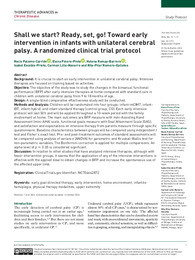Please use this identifier to cite or link to this item:
https://hdl.handle.net/11000/37941Full metadata record
| DC Field | Value | Language |
|---|---|---|
| dc.contributor.author | Palomo Carrión, Rocio | - |
| dc.contributor.author | Pinero-Pinto, Elena | - |
| dc.contributor.author | Romay Barrero, Helena María | - |
| dc.contributor.author | Escobio Prieto, Isabel | - |
| dc.contributor.author | Lillo-Navarro, Carmen | - |
| dc.contributor.author | Romero Galisteo, Rita Pilar | - |
| dc.contributor.other | Departamentos de la UMH::Patología y Cirugía | es_ES |
| dc.date.accessioned | 2025-11-07T09:03:14Z | - |
| dc.date.available | 2025-11-07T09:03:14Z | - |
| dc.date.created | 2022 | - |
| dc.identifier.citation | Therapeutic Advances in Chronic Disease. 2022 Nov 14:13:20406223221136059 | es_ES |
| dc.identifier.issn | 2040-6231 | - |
| dc.identifier.issn | 2040-6223 | - |
| dc.identifier.uri | https://hdl.handle.net/11000/37941 | - |
| dc.description.abstract | Background: It is crucial to start an early intervention in unilateral cerebral palsy. Intensive therapies are focused on training based on activities. Objective: The objective of the study was to study the changes in the bimanual functional performance (BFP) after early intensive therapies at home compared with standard care in children with unilateral cerebral palsy from 9 to 18 months of age. Design: A single-blind comparative effectiveness study will be conducted. Methods and Analysis: Children will be randomized into four groups: infant-mCIMT, infant- BIT, infant-hybrid, and infant standard therapy (control group, CG). Each early intensive protocol will last 50 h and will be applied throughout a 10-week period with the family involvement at home. The main outcomes are BFP measure with mini-Assisting Hand Assessment (mini-AHA) scale, functional goals measure with Goal Attainment Scale (GAS), and satisfaction and expectations on intensive therapy from parents measure through specific questionnaire. Baseline characteristics between groups will be compared using independent t test and Fisher’s exact test. Pre- and post-treatment outcomes of standard assessments will be compared using analysis of variance (ANOVA) for parametric and Kruskal–Wallis test for non-parametric variables. The Bonferroni correction is applied for multiple comparisons. An alpha level of p ⩽ 0.05 is considered significant. Discussion: In relation to other studies that have analyzed intensive therapies, although with fewer intervention groups, it seems that the application of any of the intensive interventions is effective with the applied dose to obtain changes in BFP and increase the spontaneous use of the affected upper limb. | es_ES |
| dc.format | application/pdf | es_ES |
| dc.format.extent | 11 | es_ES |
| dc.language.iso | eng | es_ES |
| dc.publisher | SAGE Publications | es_ES |
| dc.rights | info:eu-repo/semantics/openAccess | es_ES |
| dc.rights | Attribution-NonCommercial-NoDerivatives 4.0 Internacional | * |
| dc.rights.uri | http://creativecommons.org/licenses/by-nc-nd/4.0/ | * |
| dc.subject | early goal-directed therapy | es_ES |
| dc.subject | early intervention | es_ES |
| dc.subject | home environment | es_ES |
| dc.subject | infantile hemiplegia | es_ES |
| dc.subject | physical therapy modalities | es_ES |
| dc.subject | upper extremity | es_ES |
| dc.subject.other | CDU::6 - Ciencias aplicadas::61 - Medicina | es_ES |
| dc.title | Shall we start? Ready, set, go! Toward early intervention in infants with unilateral cerebral palsy. A randomized clinical trial protocol | es_ES |
| dc.type | info:eu-repo/semantics/article | es_ES |
| dc.relation.publisherversion | https://doi.org/10.1177/20406223221136059 | es_ES |

View/Open:
Shall we start Ready, set, go Toward early intervention in infants with unilateral cerebral palsy. A randomized clinical trial protocol.pdf
1,23 MB
Adobe PDF
Share:
.png)
